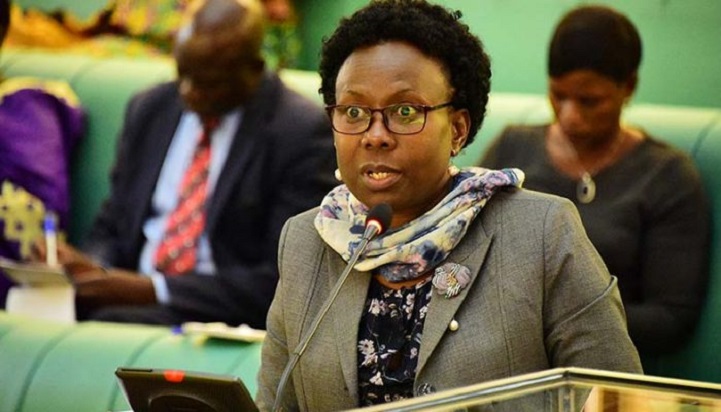Dr. Jane Ruth Aceng, the Minister for Health
One of the commitments of the NRM government in its manifesto 2021-2026 was that every sub-county would have a functional Health Centre Ill with qualified staff, a well-equipped maternity ward, increased access to family planning services, antenatal care, basic obstetric care services and postnatal care services.
To date, 381 Health Centre IIs have been upgraded to HC IIIs while 32 new Health Centre IIIs were constructed.
Dr. Jane Ruth Aceng, the Minister for Health made these revelations last week while addressing the media on how far her ministry has gone in implementing the 2021-2026 NRM manifesto commitments.
Dr. Aceng said that 37 Health Centre IIIs transitioned in refugee hosting districts.
The minister added that 1,696 out of 2,184 (78%) Sub Counties and Town Councils have a Health Centre III.
Wage was allocated for recruitment of health workers, the minister added.
Dr. Aceng revealed that up to 30,000 are the number of mothers attending the four minimum antenatal care visits.
20,000 of thee mothers are delivering from “these new Health Centre IIIs alone.”
The minister said that there is a reduction in the referrals as the bulk of the less complicated cases are now managed at the HC IIIs. She added that this has improved healthcare outreaches to communities.
Under this particular commitment, Dr. Aceng said there is no funding for construction. She added that many new sub counties and town councils have been created with no provision yet for establishing the infrastructure.
The other commitment was to reduce the high maternal deaths due to haemorrhage and other causes like ruptured uterus through installations of blood fridges in 89 HC IVs. Dr. Aceng said that maternal Mortality has reduced to 189/100,000. She, however, said that this is still below the 2030 target of 70/100,000.
Dr. Aceng said that there are more public and private HC IVs with blood fridges (108 in FY 2020/21 to 132 in FY 2022/23). She added that the number of HC IVs providing cesarean sections and blood transfusion) has increased from 50% (108/218) in FY 2020/21 to 64% (132/254 in FY 2023/24). She, however, said that there is inadequate funding for procurement of blood fridges with alternate power supply as required.
The government had also planned to fully operationalize theatres at HC IVs to provide surgical care, recruit additional 50 medical officers, 89 anaesthetic officers, 124 anaesthetic assistants and 51 theatre assistants.
These, Dr. Aceng, said are “Ongoing based on availability of wage.”
According to Dr. Aceng, a total of 170 out of 195 Public HC IVs conducted caesarean sections in FY 2022/23
She, however, said that there is inadequate wage for recruitment of specialized theatre staff as well as a shortage of qualified anaesthetic officers.
The other commitment was to establish a coordinated ambulance system with 14 medical call and dispatch centres and one ambulance command centre per region.
Dr. Aceng said that the first National Ambulance Station with a Call Centre is near completion at Naguru National Emergency and Trauma Centre. She added that her ministry working with the Uganda Police and Uganda Communications Commission is to functionalize the 911 medical emergency universal access number, and established highway road traffic accident response system with Uganda Red Cross Society.
She noted that a Regional Ambulance Call and Dispatch Centre was established at Masaka Regional Referral Hospital. The Ministry of Health also commissioned construction of four Regional Ambulance Call and Dispatch Centre: Arua, Lira, Mbale and Mbarara. Dr. Aceng said that “We plan is to have each of the 14 regional ambulance Call and Dispatch Centres responsible for 20 to 30 Type B (Basic Life support) emergency care ambulances.”
So far fundng has been provided for only 6/14 Call and Dispatch Centres, Dr. Aceng said.
Immunizaton
Dr. Aceng said that there was a commitment to scale up immunisation efforts by conducting routine immunisation services. She said that routine immunisation services were conducted through static sites and outreaches by all health facilities. She added that solar powered vaccine fridges were installed in all HC IIIs and in a number of HC IIs. Dr. Aceng revealed that the DPT3 vaccination coverage trend were 87% (FY2 020/21): 91% (FY 2021/22); 87% (FY 2022/23), and 95% (FY 24/25)
The MR1 vaccination coverage trend, Dr. Aceng said was 86% (FY 2020/21); 91% (FY 2021/22); 88% FY (2022/23) and 94% (FY 24/25). She, however, revealed that MR2 coverage is still low at 16.5%.
Dr. Aceng said there is low access to public health facilities in Kampala Metropolitan Area especially in informal settlements. The minister also reported low uptake of services in some regions e.g., West Nile, Bunyoro and Ankole. According to Dr. Aceng, the Covid-19 vaccination campaigns interrupted routine immunization activities. This, she said, is on top of lack of funds for Integrated Child Health Days in April 2023.
Dr. Aceng highlighted major plans for 2025/2026 as below:
-Promotion and implementation f integrated high impact interventions for the prevention, control and elimination of communicable, Non-Communicable and Neglected Tropical Diseases and Injuries.
-Provision of high-quality sexual and reproductive health and rights services in order to achieve optimal health for the adolescents, mothers, newborn and infants.
-Promotion of nutrition education for communities on the benefits of balanced diets, food preparation, and the importance of nutrition especially for children, pregnant women and the elderly (Geriatric care).
-Strengthen the National Ambulance System, Emergency Care and referral system.
-Establishment of strong Primary Health Care and Community Health Services; and implementation of the Community Health Strategy hinged on the Parish Development Model approach.





